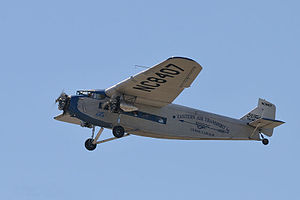Ford 3-AT
| Trimotor | |
|---|---|
 |
|
| Experimental Aircraft Association (EAA) Ford 4-AT-E Trimotor (2014) | |
| Role | Transport aircraft |
| Manufacturer | Stout Metal Airplane Division of the Ford Motor Company |
| Designer | William Bushnell Stout |
| First flight | June 11, 1926 |
| Introduction | 1926 |
| Status | 18 in existence as of 2012 |
| Primary users | about 100 airlines United States Army Air Corps United States Navy Royal Canadian Air Force |
| Number built | 199 |
| Unit cost |
about $42,000 in 1933 (about $736,000 in 2013)
|
| Variants | Stout Bushmaster 2000 |
The Ford Trimotor (also called the "Tri-Motor", and nicknamed "The Tin Goose") is an American three-engined transport aircraft. Production started in 1925 by the companies of Henry Ford and ended on June 7, 1933. A total of 199 Ford Trimotors were made. It was designed for the civil aviation market, but also saw service with military units.
The Ford Trimotor was a development of previous designs by William Bushnell Stout, using structural principles copied from the work of Professor Hugo Junkers, the noted German all-metal aircraft design pioneer, and adapted to an airframe very similar to the single engine Fokker F.VII - even using the same airfoil cross section at the wing root.
In the early 1920s, Henry Ford, along with a group of 19 other investors including his son Edsel, invested in the Stout Metal Airplane Company. Stout, a bold and imaginative salesman, sent a mimeographed form letter to leading manufacturers, blithely asking for $1,000 and adding: "For your one thousand dollars you will get one definite promise: You will never get your money back." Stout raised $20,000, including $1,000 each from Edsel and Henry Ford.
In 1925, Ford bought Stout and its aircraft designs. The single-engined Stout monoplane was turned into a trimotor, the Stout 3-AT with three Curtiss-Wright air-cooled radial engines. After a prototype was built and test-flown with poor results, and a suspicious fire caused the complete destruction of all previous designs, the "4-AT" and "5-AT" emerged.
The Ford Trimotor using all-metal construction was not a revolutionary concept, but it was certainly more advanced than the standard construction techniques of the 1920s. The aircraft resembled the Fokker F.VII Trimotor (except for being all-metal which Henry Ford claimed made it "the safest airliner around"). Its fuselage and wings followed a design pioneered by Junkers during World War I with the Junkers J.I and used postwar in a series of airliners starting with the Junkers F.13 low-wing monoplane of 1920 of which a number were exported to the US, the Junkers K 16 high-wing airliner of 1921, and the Junkers G 24 trimotor of 1924. All of these were constructed of aluminum alloy, which was corrugated for added stiffness, although the resulting drag reduced its overall performance. So similar were the designs that Junkers sued and won when Ford attempted to export an aircraft to Europe. In 1930, Ford countersued in Prague, and despite the possibility of anti-German sentiment, was decisively defeated a second time, with the court finding that Ford had infringed upon Junkers' patents.
...
Wikipedia
